Magic in the Wines from Corralitos
The Santa Cruz Mountains appellation is quite large at 350,000 acres and is spread
over three counties, extending from Half Moon Bay in the north to Mount Madonna
just north of Watsonville in the south. Tucked away in the southwest corner of the
appellation is the tiny town of Corralitos (9 square miles), home to only 5 of the
more than 90 wineries in the appellation. Despite its small size and the infancy of
most of its vineyards, the Pinot Noirs and Chardonnays from Corralitos have been
strikingly good and knowledgeable pinotphiles are beginning to take notice.
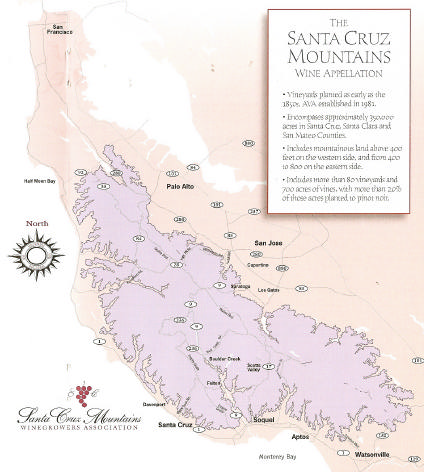
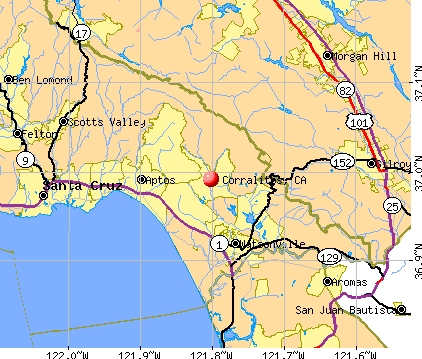
Corralitos is an agricultural area, well known for apples
(“Apple City of the West”) and strawberries (“Strawberry
Capital of the World”). It is bordered on the west by flatlands
leading to the Pacific Ocean, which is only 3 to 5 miles
away, and on the east by modest hills rising to 1,000 feet.
Santa Cruz is 17 miles to the north, Monterey 20 miles to the
south. Dotted with “McMansions” bought with Silicon Valley
money, this rural area is blessed with unpolluted air and
well-drained loamy sand soils underlain with some limestone.
The most distinguishable landmark is the Corralitos
Market and Sausage Co. located on Corralitos Road and
known for superb bacon, sausages, and other meats.
The origin of the name Corralitos is not definitively known.
According to Judy Malmin, author of the book Corralitos, the name comes from the Spanish meaning
two or more small yards or enclosures or little corrals. By 1820, the name Corralitos was in common
use and in 1823 it was the name given to a land grand rancho that included Corralitos, Rancho de Los
Corralitos.
I visited the area in early July of this year. The photo below was taken while driving over the Santa
Cruz Mountains summit as one approaches Corralitos from Highway 101 located to the east. The
Pacific Ocean can be seen in the far distance. The vineyards are situated on the southwest facing hillsides
in the foothills of the large north-south oriented Santa Cruz Mountain range.
The close proximity of Corralitos to the Pacific Ocean is ideal for farming grapes. The summers are
dry and warm with foggy mornings and the winters are cool and moist with annual rainfall between 12
and 30 inches. Large temperature swings are not unusual, with 90° days followed by 50° nights. The
growing season here is probably the longest of any viticultural area in California, with bud break in
early February and harvest extending all the way into the first days of November.
Craig Handley, proprietor of Pleasant Valley Vineyards in Corralitos, has spearheaded the “Corralitos
Wine Trail,” consisting of five relatively new, family-owned, small wineries located in close proximity
(Alfaro Family Vineyards, Natal Vineyards, Nicholson Vineyards, Pleasant Valley Vineyards, and
Windy Oaks Estate Vineyards & Winery). A sixth winery, Storrs, is planting a vineyard adjacent to
Alfaro Family Vineyards and building a new winery which will open next year. All of the wineries are
only open by appointment except for special occasions. On September 15, 2007, all of the wineries
will have Open Houses from 12 to 5 as part of the second annual Corralitos Wine Trail Event. Tickets
are $30 per person in advance and include wine tasting, barrel tasting, a commemorative crystal glass,
Corralitos sausage tasting, cheese tasting, and self-catered picnicking at select vineyards. All of the
participating wineries are within 6 miles of one another. For tickets and maps, consult the participating
wineries websites or www.corralitoswinetrail.com.
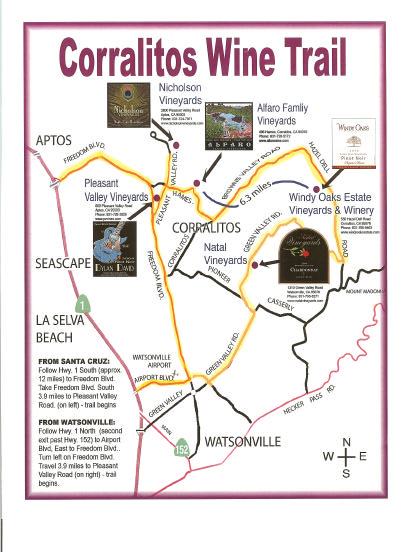
When I visited Corralitos, I spent some time with Richard Alfaro of Alfaro Family Vineyards and Jim
and Judy Schultze of Windy Oaks Estate Vineyards & Winery. Profiles of both wineries and tasting
notes follow.
Alfaro Family Vineyards and Martin Alfaro Wines
Richard Alfaro’s background is in bread making, but he has had a personal interest in wine for over
twenty-five years. He founded Alfaro’s Micro-Bakery in Watsonville in 1988 and subsequently sold it to
Sarah Lee in 1998 giving him the funds to start a winery. Always a Cabernet and Bordeaux lover, it was
in 1996 that he had his Pinot Noir epiphany. He was having dinner in Lake Tahoe with a friend and ordered
a 1994 Rex Hill Reserve Willamette Valley Pinot Noir. He was taken by the wine and returned to
the same restaurant the next evening to confirm his impressions. He ordered another bottle of the
same wine and it was even better the second time. Having lived in the Monterey Peninsula, he was
familiar with Corralitos and had quite an attraction to the Chardonnay from the Christie Vineyard. He
saw the potential of the area for winegrowing and found a 75-acre property in 1998 that was suitable.
Today, he has the largest planting of Pinot Noir in the Santa Cruz Mountains (22 acres) and will release
12 different Pinot Noirs from the 2006 vintage. Besides his estate fruit, he sources Pinot Noir from
Garys’ Vineyard and Sleepy Hollow Vineyard in the Santa Lucia Highlands, Franscioni Vineyard in
Monterey County, an unnamed vineyard in the Sonoma Coast, Gemelli Vineyard in Cienega Valley
and vineyards in Corralitos. Production is about 4,500 cases per year.
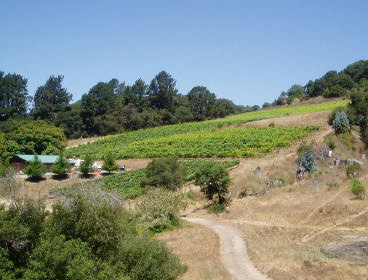
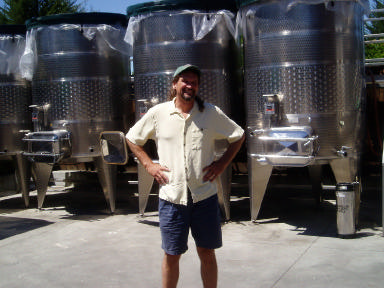
Richard drove me around Corralitos pointing out the most notable vineyards. The Deer Park Vineyard
is owned by Dan Lester and managed by Prudy Foxx who is a well-respected viticulturalist in the Santa
Cruz Mountains. This vineyard has multiple clones including 115, 667, 777, 37 (Mt. Eden), Wädenswil,
and Mariafeld. The Christie Vineyard plantings are 20-25 years old (the first planted in Corralitos) and
consist of both Pinot Noir and Chardonnay. Other vineyards include Saveria Vineyard, Pleasant Valley
Vineyard and Schultze Family Vineyard. There are several small 1 to 3 acre vineyards as well in the
region. Storrs Winery is currently planting a Pinot Noir vineyard.
Next year, Richard will be planting Mary K’s Vineyard, named after his wife to celebrate their 25th
Anniversary together. The vineyard will contain heritage clones of Chardonnay and own-rooted vines
from a Vosne-Romanee Grand Cru Monopole vineyard.
I sat down with Richard in his winery and tasted through several of his wines. He produces two lines:
Alfaro Family Vineyard wines from estate fruit, and Martin Alfaro wines from purchased fruit. The
name Martin comes from Joe Martin who is a partner and winemaker at Alfaro. Richard has a wealth of
information about Corralitos and a visit to this area would not be complete without meeting him and
experiencing his passion and energy that he possesses for winegrowing.
this.fmt_tasting_notes(275,276,277,278,279,280,281): 275
Windy Oaks Estate Vineyard & Winery
Sometimes you come upon a winemaker (Ted Lemon comes to mind) and after you spend a little time
with him or her, you just know they get it. Jim Schultze is in the same mold. He has a charming calm
and trustworthy demeanor and his approach to wine is meticulous and well thought-out. You just get
the feeling that his grapes are in good hands. If I was a Pinot Noir grape, I would like Jim to raise me
and make me into a fine wine. Jim expresses his philosophy so succinctly: “I do the most I can in the
vineyard and the least I can in the winery.”
Jim and Judy Schultze are escapees from the high-tech world who have used their twenty years of
interest and experience in artisan winemaking and winegrowing to create Windy Oaks Estate. The
Burgundian varietals, Pinot Noir and Chardonnay, are produced from a 15-acre vineyard located at
1,000 feet on a ridge overlooking the town of Corralitos and the Monterey Bay beyond.
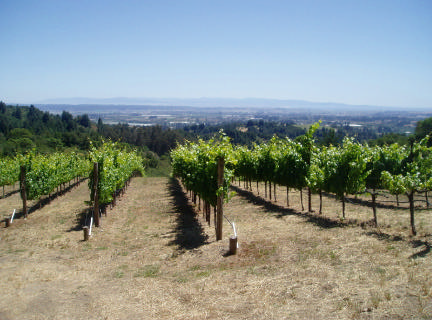
Viticulture and winemaking here is very Burgundy-themed. The vineyard is farmed according to sustainable,
organic principles with all of the wines hand-tended and directly monitored for water status.
The vineyard is mostly above the fog line. Summer is free of heat spikes with temperatures in the 70s
and 40s at night. The site is extraordinary and yields physiologically ripe grapes without high brix and
high natural acidity. Clones are 115,667, 777, 828, 2A and Pommard. Winemaking is noninterventional
with no additives (ie enzymes, acid). Jim employs a 4 to 6 day cold soak and uses a basket
press. Fermentations use 50% wild yeast and last 25-30 days. No racking is done once the wine is
in barrel. The Schultzes travel yearly to Burgundy to meet with coopers. They use 3-year-old air dried
tight grained French oak barrels and age their Pinot Noirs for 18-25 months with a high percentage of
new oak (50% up to 75% in the Reserve). The modern estate winery is all gravity-driven. They use a
state-of-the-art bottling line with minimal oxygen uptake yielding wines that go through little or no
bottling shock.
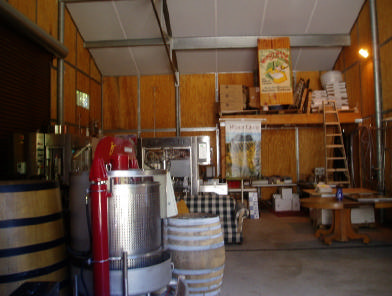
I visited the winery and was quite impressed. Jim is experimenting with wood tank fermentation and
just released the
2005 Windy Oaks Estate Tank Fermented Pinot Noir (26 cases, $55). The wood
fermentor is in the photo at left. After tasting the results of this fermentation method in France, Jim believes
wines fermented in wood develop smooth, well-integrated tannins,
a round mouth feel, and excellent preservation of fruit with good
complexity and a long finish. This initial release is from the estate
vineyard’s Bay Block (which typically provides the majority of the
Reserve). The wine was aged for 22 months in 100% new French oak.
Another new release is the
2005 Windy Oaks Estate Special Burgundian
Clone Pinot Noir (26 cases, $95). This is a release from a
special half-acre block at the top of the vineyard ridge. Jim tends this
block himself, doing everything from pruning to leaf pulling to tucking
vines. This special Pinot Noir clone came from Burgundy and tastes
similar to its Burgundian counterpart. Aged 27 months in 100% new
French oak. The wine is being offered in a beautiful wood box with the
a poster silk-screened on the bottle that was created by noted French
poster artist, Jean-Pierre Got (pictured right).
2004 Windy Oaks Estate Proprietor’s Reserve Santa Cruz Mountains Pinot Noir
175 cases, $45, sold out. The Reserve is the winery’s signature wine.
·
This one will stand up to any wine produced in California and is everything you
could hope for in a Pinot Noir. From classic Pinot aromatics of Bing cherry and
spice, through elegant, sweet and vivid fruit with a caressing texture, to a lasting
finale, this is one impressive drink. You won’t be able to get enough of this one.
Windy Oaks Estate sells 85% of their wine directly to a mailing list. There is not a lot of wine to go
around. I almost hesitate to rave about it. The website is www.windyoaksestate.com. 831-786-9463.